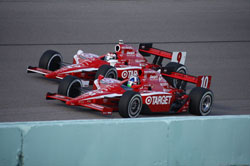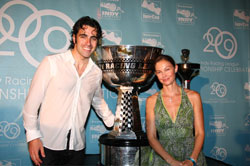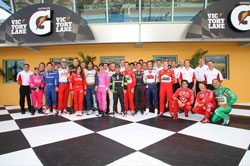Indy Racing League Speeds Full-Throttle into 2010
- Oct 19, 2009
If you've been locked in the garage for the past 16 years restoring that Silver Thunderbird - possibly there's a chance you haven't heard about the IRL. So, and for the sake of continuing higher race educations everywhere, let's recap shall we. Founded in 1994, the Indy Racing League serves as the sanctioning body for the IndyCar Series, the premier open-wheel racing series in the United States, and Firestone Indy Lights, which serves as an indispensable starting-grid for drivers striving to reach the IndyCar Series.
The IRL competes on a demanding combination of super-speedways, short ovals, scenic road courses and temporary street circuits. As the leader in motorsports technology, the IndyCar Series is the first racing series to power its Honda engines on 100 percent fuel-grade ethanol, a renewable and environmentally friendly fuel. In spirit, taking an initial major step towards greener racing practices.
Without exception the IndyCar Series continues to the be the fastest, most competitive and innovative racing series, attracting a diverse lineup of driver superstars including Helio Castroneves ,Scott Dixon, Danica Patrick, Graham Rahal, Marco Andretti, Dan Wheldon, Dario Franchitti, Tony Kanaan and Ryan Briscoe.
Tony George announced plans March 11,1994, for an oval-based, open-wheel racing series that would include the Indianapolis 500, the world's most famous race, as its centerpiece. The Indy Racing League, which took its name on July 8, 1994, was formed to preserve the traditions and excitement of America's open-wheel oval racing. George represents the third generation of Indianapolis Motor Speedway ownership for the Hulman family of Terre Haute, Indiana. Anton "Tony" Hulman, the grandfather for whom George is named, purchased the speedway in 1945. The first offical IRL event was the Indy 200, Jan. 27, 1996, at Walt Disney World Speedway in Lake Buena Vista, Florida. Buzz Calkins took the checkered in that race.
Brian Barnhart, who has been with the league since its origin, serves as president of competition and racing operations. Terry Angstadt joined the league in 2007 and serves as president of the league's commercial division.
It is a well-documented fact that IndyCar Series manufacturer partners use information gained from the racetrack to directly improve the products they sell to consumers. That's interesting when you consider that an IndyCar Series vehicle and a regular passenger car have so little in common. Every IndyCar uses a K&N air filter as do many passenger cars for performance and protection, however, you'll find a lot more contrasts than similarities between the two.
"The modern day IndyCar Series car is the product of a decades-long pursuit of speed and performance," said IndyCar Series Senior Technical Director Les Mactaggart. "Since the dawn of auto racing, these cars have been continuously tested and improved, and the result is one of the fastest, most finely-tuned racing machines in the world. They're bred for speed, not for getting your family about town."
Here are a few amusing and revealing comparisons between the cars that fans will be driving to the race, and the IndyCar Series cars that they will be watching compete. IndyCar Series cars reach speeds of 220 mph. A fan traveling 30 miles on the highway at 65 mph to come to this weekend's race will require just under 28 minutes to make the trip. An IndyCar Series car making the same trip at 200 mph would require just nine minutes. Assuming there aren't any red lights.
When it comes to speed and performance, it's hard to overstate the differences. The IndyCar Series Honda V-8 engines produce between three and four times the horsepower of the average passenger car. In the same amount of time that it takes a 2008 V-6 Honda Accord Coupe to go from zero to 60 mph (around six seconds), an IndyCar Series car can go from zero to 100 mph and back to zero again.
The Firestone racing tires used by the IndyCar Series have roughly the same thickness as a credit card. During a race, their surface can reach temperatures in excess of 200 degrees Fahrenheit and will have to be changed every 65-70 miles. Passenger car tires, being thicker and running cooler, can last as long as 50,000 miles or more.
No one is more qualified to discuss the similarities and differences than a racer - IndyCar Series driver Vitor Meira, put it this way, "The biggest difference between the IndyCar Series car and my passenger car is speed limit signs. There aren't any at the racetrack. The greatest tool that I have in a streetcar that I don't have in my racecar is cruise control. That saves me a lot of money on speeding tickets."
The relationship between K&N and the IRL has been long-standing. Asked to comment about it, spokesperson Rebecca Simon had this to say, "With its commitment to quality, excellence and innovation, K&N's product enhances on-track performance as the only air filter used by the IndyCar Series. Additionally, K&N's relentless drive, and race-bred innovation, provides a unique marketing platform that aligns well with the IndyCar Series brand."
The IndyCar Series recently wrapped up its 2009 championship with Dario Franchitti taking the title in a winner-take-all battle at Homestead-Miami Speedway. The IndyCar Series announced its 2010 schedule in August, with 17 races planned for next year.
The complete 2010 IndyCar Series schedule:
Find K&N products for your vehicle using the K&N application search then use the K&N dealer search to find a K&N dealer in your part of the world.
The IRL competes on a demanding combination of super-speedways, short ovals, scenic road courses and temporary street circuits. As the leader in motorsports technology, the IndyCar Series is the first racing series to power its Honda engines on 100 percent fuel-grade ethanol, a renewable and environmentally friendly fuel. In spirit, taking an initial major step towards greener racing practices.
Without exception the IndyCar Series continues to the be the fastest, most competitive and innovative racing series, attracting a diverse lineup of driver superstars including Helio Castroneves ,Scott Dixon, Danica Patrick, Graham Rahal, Marco Andretti, Dan Wheldon, Dario Franchitti, Tony Kanaan and Ryan Briscoe.
Tony George announced plans March 11,1994, for an oval-based, open-wheel racing series that would include the Indianapolis 500, the world's most famous race, as its centerpiece. The Indy Racing League, which took its name on July 8, 1994, was formed to preserve the traditions and excitement of America's open-wheel oval racing. George represents the third generation of Indianapolis Motor Speedway ownership for the Hulman family of Terre Haute, Indiana. Anton "Tony" Hulman, the grandfather for whom George is named, purchased the speedway in 1945. The first offical IRL event was the Indy 200, Jan. 27, 1996, at Walt Disney World Speedway in Lake Buena Vista, Florida. Buzz Calkins took the checkered in that race.
Brian Barnhart, who has been with the league since its origin, serves as president of competition and racing operations. Terry Angstadt joined the league in 2007 and serves as president of the league's commercial division.
It is a well-documented fact that IndyCar Series manufacturer partners use information gained from the racetrack to directly improve the products they sell to consumers. That's interesting when you consider that an IndyCar Series vehicle and a regular passenger car have so little in common. Every IndyCar uses a K&N air filter as do many passenger cars for performance and protection, however, you'll find a lot more contrasts than similarities between the two.
"The modern day IndyCar Series car is the product of a decades-long pursuit of speed and performance," said IndyCar Series Senior Technical Director Les Mactaggart. "Since the dawn of auto racing, these cars have been continuously tested and improved, and the result is one of the fastest, most finely-tuned racing machines in the world. They're bred for speed, not for getting your family about town."
Here are a few amusing and revealing comparisons between the cars that fans will be driving to the race, and the IndyCar Series cars that they will be watching compete. IndyCar Series cars reach speeds of 220 mph. A fan traveling 30 miles on the highway at 65 mph to come to this weekend's race will require just under 28 minutes to make the trip. An IndyCar Series car making the same trip at 200 mph would require just nine minutes. Assuming there aren't any red lights.
When it comes to speed and performance, it's hard to overstate the differences. The IndyCar Series Honda V-8 engines produce between three and four times the horsepower of the average passenger car. In the same amount of time that it takes a 2008 V-6 Honda Accord Coupe to go from zero to 60 mph (around six seconds), an IndyCar Series car can go from zero to 100 mph and back to zero again.
The Firestone racing tires used by the IndyCar Series have roughly the same thickness as a credit card. During a race, their surface can reach temperatures in excess of 200 degrees Fahrenheit and will have to be changed every 65-70 miles. Passenger car tires, being thicker and running cooler, can last as long as 50,000 miles or more.
No one is more qualified to discuss the similarities and differences than a racer - IndyCar Series driver Vitor Meira, put it this way, "The biggest difference between the IndyCar Series car and my passenger car is speed limit signs. There aren't any at the racetrack. The greatest tool that I have in a streetcar that I don't have in my racecar is cruise control. That saves me a lot of money on speeding tickets."
The relationship between K&N and the IRL has been long-standing. Asked to comment about it, spokesperson Rebecca Simon had this to say, "With its commitment to quality, excellence and innovation, K&N's product enhances on-track performance as the only air filter used by the IndyCar Series. Additionally, K&N's relentless drive, and race-bred innovation, provides a unique marketing platform that aligns well with the IndyCar Series brand."
The IndyCar Series recently wrapped up its 2009 championship with Dario Franchitti taking the title in a winner-take-all battle at Homestead-Miami Speedway. The IndyCar Series announced its 2010 schedule in August, with 17 races planned for next year.
The complete 2010 IndyCar Series schedule:
| Date | Location | Venue |
| Sunday, March 14 | TBA, Brazil | TBA |
| Sunday, March 28 | Streets of St. Petersburg, Fla. | 1.8-mile street-course |
| Sunday, April 11 | Barber Motorsports Park | 2.38-mile road course |
| Sunday, April 18 | Streets of Long Beach, Calif. | 1.968-mile street course |
| Saturday, May 1 | Kansas Speedway | 1.5-mile oval |
| Sunday, May 30 | Indianapolis Motor Speedway | 2.5-mile oval |
| Saturday, June 5* | Texas Motor Speedway | 1.5-mile oval |
| Sunday, June 20 | Iowa Speedway | .875-mile oval |
| Sunday, July 4 | Watkins Glen International | 3.37-mile road course |
| Sunday, July 18 | Streets of Toronto | 1.721-mile street course |
| Sunday, July 25 | Edmonton City Centre Airport | 1.973-mile airport course |
| Sunday, Aug. 8 | Mid-Ohio Sports Car Course | 2.258-mile road course |
| Sunday, Aug. 22 | Infineon Raceway | 2.245-mile road course |
| Saturday, Aug. 28* | Chicagoland Speedway | 1.5-mile oval |
| Saturday, Sept. 4* | Kentucky Speedway | 1.5-mile oval |
| Saturday, Sept. 18 | Twin Ring Motegi | 1.5-mile oval |
| Saturday, Oct. 2* | Homestead-Miami Speedway | 1.5-mile oval |
| * Denotes night race | Schedule Subject to Change | |
Find K&N products for your vehicle using the K&N application search then use the K&N dealer search to find a K&N dealer in your part of the world.













